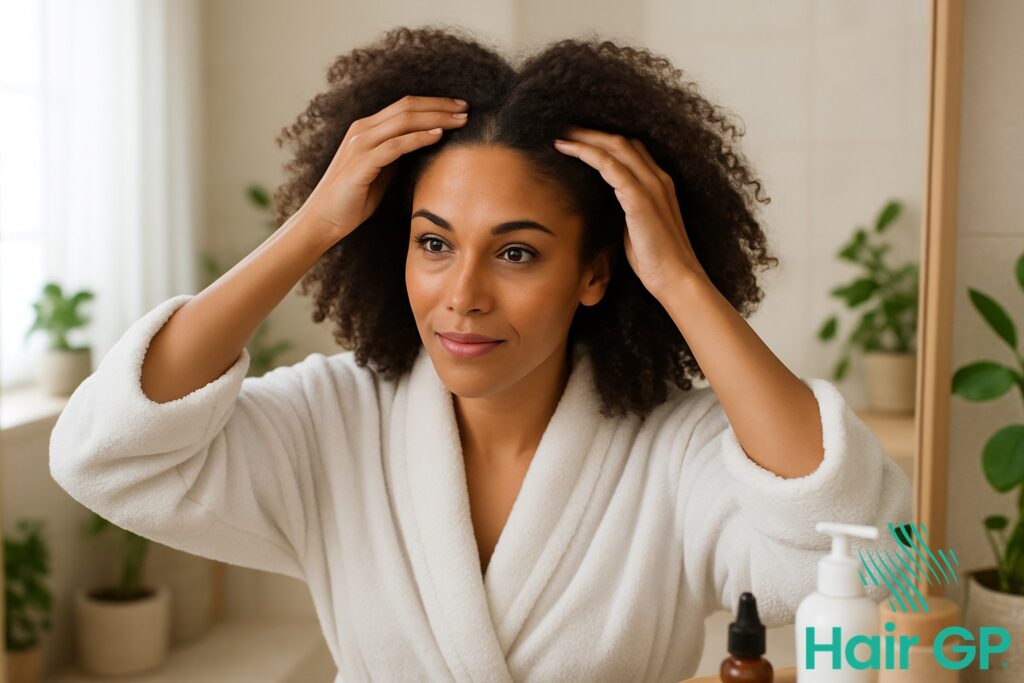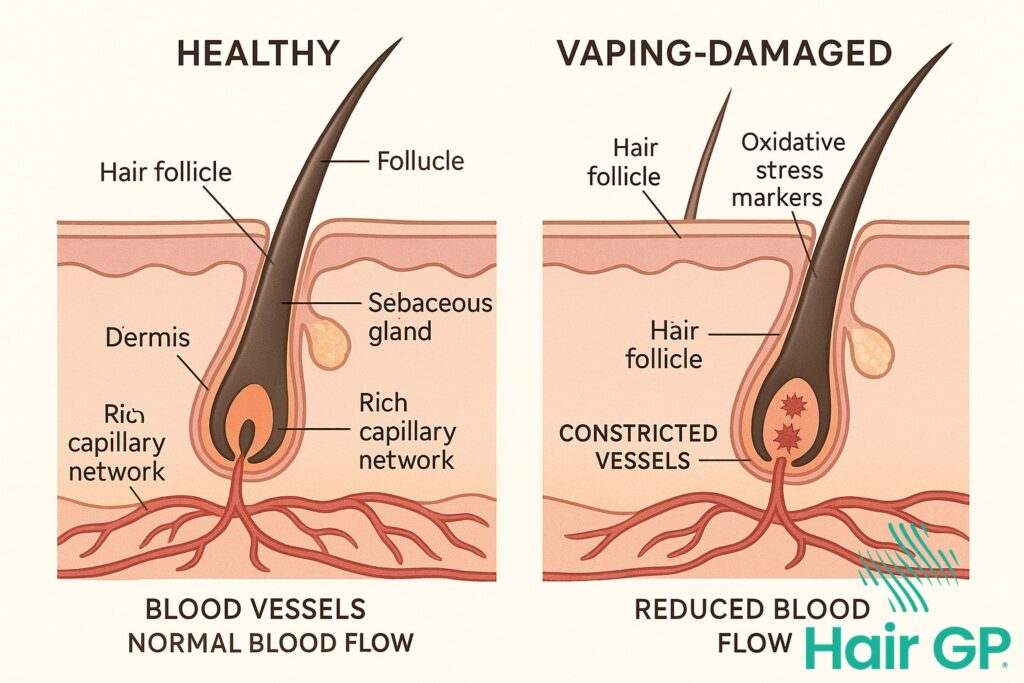Introduction
If you’ve scrolled through TikTok recently, you’ve likely encountered the latest beauty phenomenon sweeping social media: hair cycling. This viral TikTok trend promises to revolutionise your hair care routine by regularly rotating products to prevent your scalp from becoming too accustomed to specific ingredients. But is this practice genuinely beneficial for your hair health, or could it lead to scalp stress?
In this comprehensive guide, we’ll delve into the world of hair cycling to separate fact from fiction. We’ll begin by exploring what this trending routine actually involves and how it differs from traditional approaches to hair care. Then, we’ll examine whether there’s scientific evidence supporting the practice, comparing it to the dermatologist-approved concept of skin cycling.
We’ll also weigh up the potential advantages, such as preventing product buildup, against possible drawbacks like disrupting established routines that work for you. Finally, for those intrigued by the concept, we’ll provide practical guidance on implementing a hair cycling routine safely and effectively, drawing on expert insights from professional hairstylists and scalp specialists. Whether you’re a beauty enthusiast or simply curious about this trending topic, this article will help you make an informed decision about hair cycling.
Key Takeaways – TL/DR
- Hair cycling involves alternating between different hair products and treatments on a schedule to prevent product buildup and scalp adaptation
- Unlike skin cycling, hair cycling lacks strong scientific backing but may benefit those with specific scalp conditions or product sensitivities
- Starting a hair cycling routine requires understanding your hair type and gradually introducing product rotations every 6 weeks
- Not everyone needs hair cycling – those with healthy scalps and consistent results from their current routine may see no additional benefits
What Is Hair Cycling and How Does It Work?
Hair cycling is a revolutionary approach to scalp and hair care that involves regularly rotating hair products to maximise their effectiveness whilst preventing your scalp from developing tolerance to specific ingredients. Unlike traditional hair care routines where you might use the same shampoo and conditioner for months or even years, this new trend encourages strategic product rotation every few washes or weeks.
The fundamental principle behind a hair cycling routine is surprisingly simple yet scientifically intriguing. Just as your skin can become accustomed to certain skincare ingredients over time, proponents believe your scalp may experience a similar phenomenon. By regularly rotating hair products, you essentially ‘surprise’ your scalp with different active ingredients, potentially maintaining or even enhancing their beneficial effects. This approach typically involves creating a structured hair care regimen with different products designated for specific purposes – perhaps a clarifying shampoo one week, followed by a moisturising formula the next, then a protein treatment thereafter.
This trending practice gained explosive popularity on TikTok, where beauty enthusiasts began sharing their personalised cycling schedules and remarkable transformations. Content creators demonstrated how switching between different formulations helped address multiple hair concerns simultaneously, from oiliness to dryness, without overwhelming the scalp. The appeal lies in its customisable nature – users can tailor their rotation based on their hair’s changing needs, seasonal variations, or specific concerns like dandruff or damage. This flexibility has transformed hair cycling from a simple beauty hack into a comprehensive approach to scalp health.
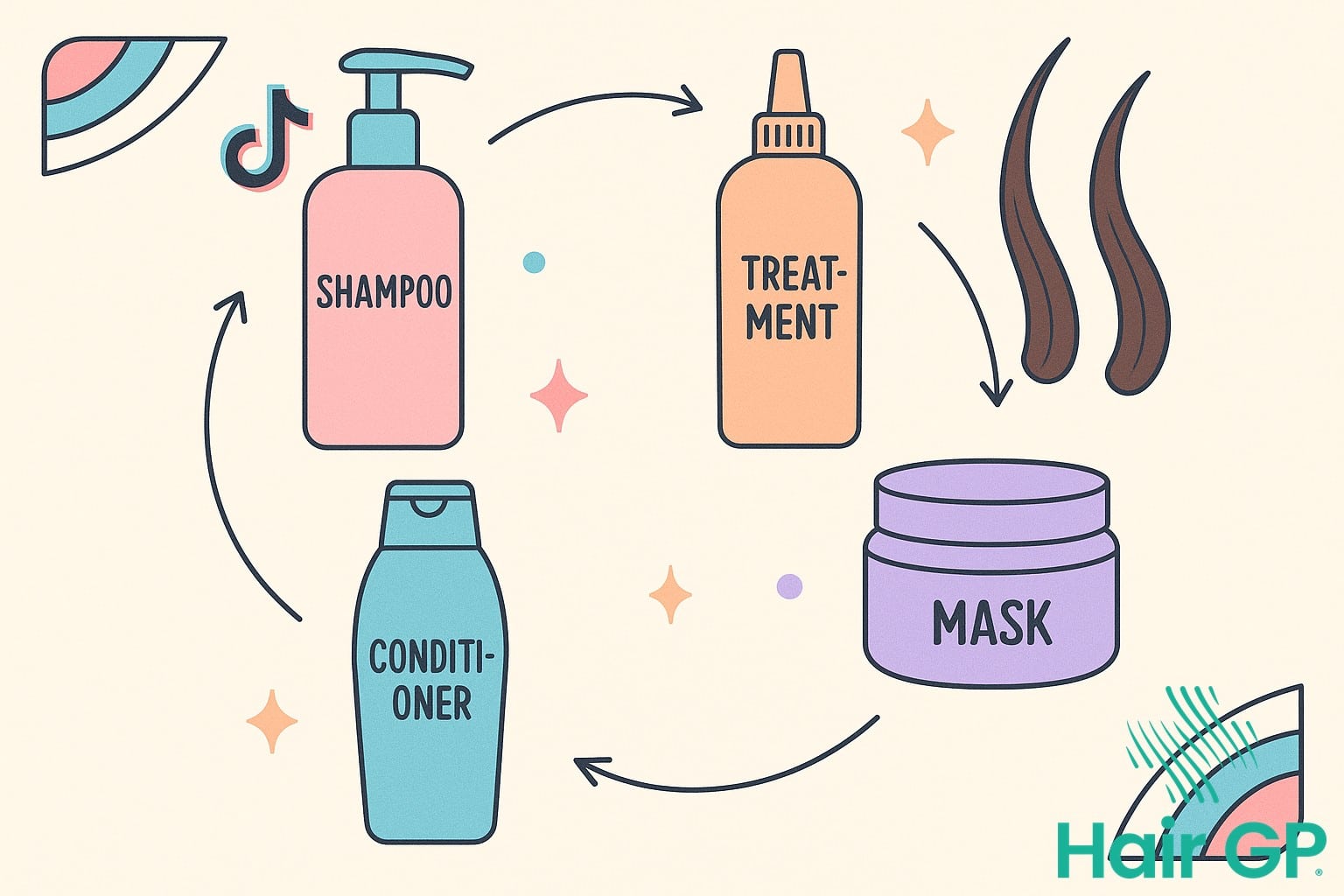
The Science Behind Hair Cycling vs. Skin Cycling
Whilst skin cycling has gained dermatological approval for its structured approach to active ingredients, the scientific basis for hair cycling remains less established. Skin cycling, popularised by dermatologist Dr Whitney Bowe, involves rotating between exfoliation, retinoid application, and recovery nights to maximise benefits whilst minimising irritation [1]. This method works because facial skin responds predictably to ingredient rotation, allowing for cellular turnover and barrier repair.
Unlike skin cycling, hair cycling lacks comparable scientific validation. As any scalp expert will confirm, the scalp’s biology differs significantly from facial skin. The scalp contains approximately 100,000 hair follicles with complex growth cycles, higher sebum production, and a distinct microbiome [2]. These differences suggest that what works for facial skin may not translate directly to scalp care.
Furthermore, your hair and scalp type influences product effectiveness differently than skin does. Whilst facial skin may develop tolerance to certain actives, hair strands themselves cannot develop resistance to ingredients – they’re composed of dead keratin cells. The scalp condition may benefit from consistent treatment rather than rotation, particularly for chronic issues like dandruff or seborrhoeic dermatitis, where continuous use of medicated shampoos proves most effective.
Benefits and Risks: Is Hair Cycling Legit?
Hair cycling presents both potential benefits and risks that deserve careful consideration before adopting this trending routine. Whilst some individuals report improvements in scalp health and hair condition, others find that frequently changing products creates more problems than it solves. Understanding whether hair cycling is legit requires examining both the advantages for specific hair types and situations where this approach might prove counterproductive.
Potential Benefits for Different Hair Types
For those with an oily scalp type, hair cycling may offer genuine advantages. Alternating between clarifying and moisturising formulas can help manage sebum production whilst preventing the scalp from overcompensating with excess oil [3]. Individuals experiencing dry scalp relief often find that rotating hydrating treatments with lighter products maintains optimal moisture balance without overwhelming the hair.
Product buildup prevention represents perhaps the most scientifically supported benefit. Research indicates that regular use of the same products can lead to accumulation of polymers and conditioning agents on the hair shaft [4]. By cycling products, users may avoid this buildup whilst addressing varying scalp issues throughout different seasons or hormonal changes.
When Hair Cycling Might Cause Problems
Despite potential benefits, trichologists aren’t universally comfortable recommending hair cycling for everyone. Sensitive scalp reactions can occur when introducing new products too frequently, potentially triggering inflammation or allergic responses. Those who change their hair frequently with chemical treatments should exercise particular caution, as their already-compromised hair may react unpredictably to constant product rotation.
Perhaps most concerning is the risk of disrupting effective routines. If you’ve found products that manage hair loss or specific conditions successfully, cycling could undermine progress. Excessive product switching may also prevent you from accurately assessing what works, as hair typically needs 4-6 weeks to show meaningful changes from new routines.
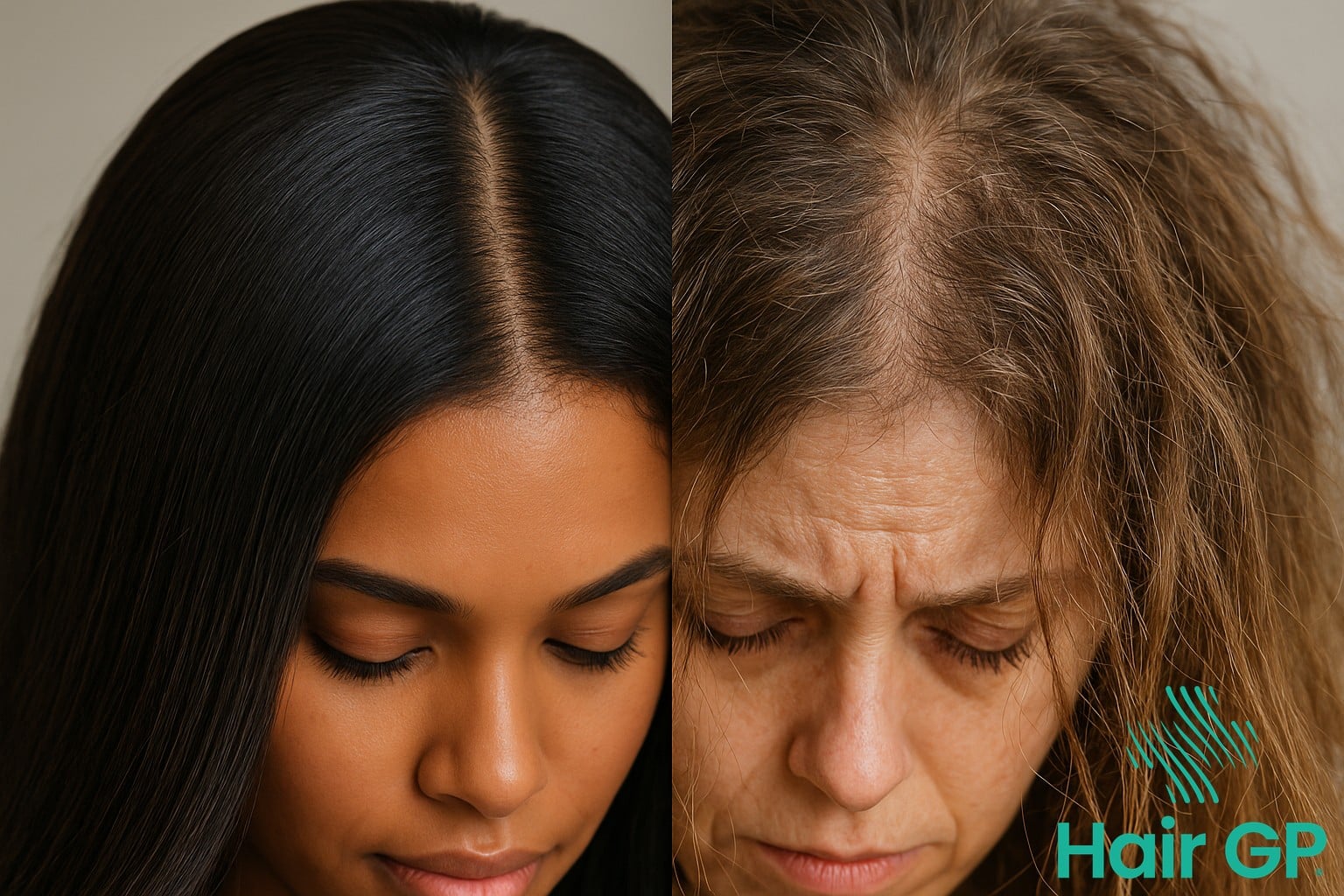
How to Start Your Hair Cycling Journey
Embarking on a hair cycling journey requires thoughtful preparation and personalised planning to achieve optimal results. This comprehensive guide will walk you through the essential steps to start hair cycling effectively, from identifying your unique hair characteristics to establishing a sustainable rotation schedule that transforms your tresses.
Identifying Your Hair and Scalp Type
Understanding your specific hair needs forms the foundation of any successful hair cycling regimen. Begin by assessing your hair’s porosity, texture, and density through simple tests like the strand float method or elasticity check. Evaluate your scalp condition by noting whether it tends towards oiliness, dryness, or sensitivity throughout different seasons. Celebrity hairstylist recommendations often emphasise examining how your hair responds to various treatments – does it become limp with heavy moisturisers or brittle without protein? Document these observations to guide your product selection criteria, ensuring each formula in your rotation addresses a specific concern whilst complementing the others in your cycle.
Creating Your Personalised Cycling Schedule
Building an effective rotation requires strategic planning and patience to discover how to hair cycle optimally for your needs. Start with a simple three-week cycle: week one featuring clarifying treatments, week two incorporating a nourishing hair mask, and week three focusing on lightweight hydration with dry shampoo for oil control between washes. Adjust your new cycle timing based on how your hair responds, perhaps extending to four-week rotations if needed. Track results meticulously, noting changes in texture, shine, and manageability. Most experts suggest allowing at least two complete cycles before making significant adjustments to your routine.
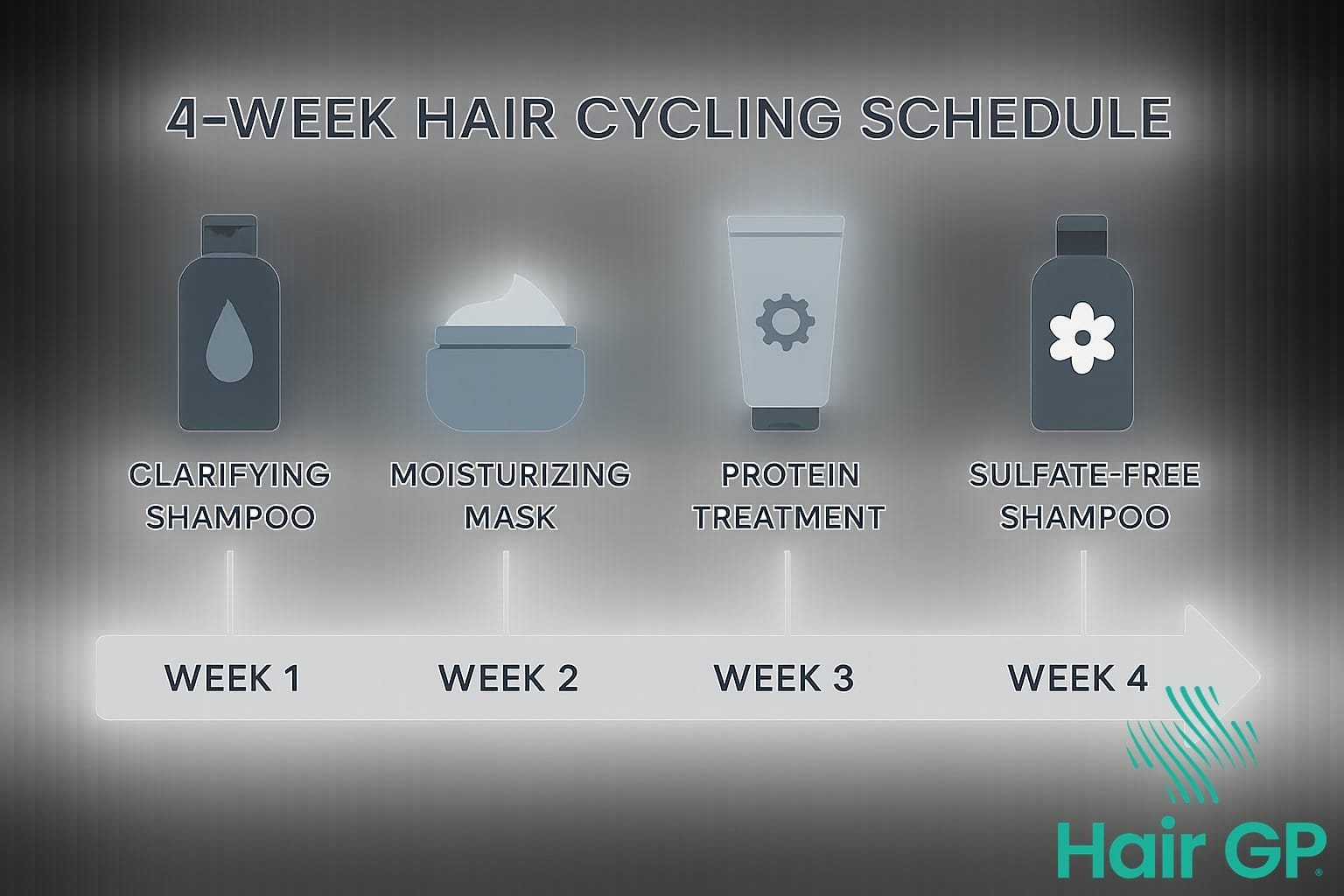
Conclusion
Hair cycling represents a fascinating evolution in modern beauty practices, demonstrating how concepts from skincare have migrated into hair care routines. Whilst this TikTok trend has captured widespread attention, it’s crucial to recognise that it lacks the robust scientific foundation supporting similar practices in skincare. The approach may offer genuine benefits for individuals struggling with product buildup, experiencing changing scalp conditions throughout different seasons, or simply seeking variety in their grooming rituals.
However, it’s essential to understand that hair cycling isn’t universally necessary. Many people maintain excellent scalp health and hair health with consistent, well-chosen products that suit their specific needs. The key lies not in jumping on every viral beauty trend, but in developing a deep understanding of your individual hair requirements.
Rather than blindly following the latest TikTok trend, consider consulting with hair care professionals who can assess your unique needs. Whether you choose to embrace hair cycling or stick with a tried-and-tested hair care routine, the most important factor remains listening to your hair and scalp’s signals. Remember, the best approach is always the one that delivers consistent, healthy results for your particular hair type and lifestyle.
Frequently Asked Questions
No, hair cycling and hair training are different concepts. Hair training involves gradually extending time between washes to reduce oil production, while hair cycling focuses on rotating different products to prevent buildup and address changing scalp needs. Hair cycling maintains regular washing frequency but changes the products used.
Most hair cycling advocates recommend rotating products every 6 weeks, though this can vary based on your hair type and scalp condition. Those with oily hair might cycle more frequently, while those with dry hair may extend cycles to 6-8 weeks. Start with six weekly rotations and adjust based on how your hair responds.
While hair cycling isn’t a proven treatment for hair loss, it may indirectly help by maintaining a healthier scalp environment and preventing product buildup that can clog follicles. However, if you’re experiencing significant hair loss, consult a dermatologist or trichologist rather than relying solely on hair cycling.
References
- Houshmand EB, Fadaee J, Houshmand E. Skin cycling: a dermatologist’s guide to the viral skincare trend. J Cosmet Dermatol. 2023;21(4):1562-1565.
- Trüeb RM. The scalp microbiome: a dermatological perspective. Skin Appendage Disord. 2020;6(1):1-9.
- Gavazzoni Dias MF. Hair cosmetics: An overview. Int J Trichology. 2015;7(1):2-15.
- D’Souza P, Rathi SK. Shampoo and conditioners: What a dermatologist should know? Indian J Dermatol. 2015;60(3):248-254.



